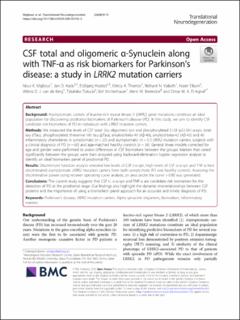| dc.contributor.author | Majbour, Nour K | |
| dc.contributor.author | Aasly, Jan | |
| dc.contributor.author | Hustad, Eldbjørg | |
| dc.contributor.author | Thomas, Mercy A | |
| dc.contributor.author | Vaikath, Nishant N | |
| dc.contributor.author | Elkum, Naser | |
| dc.contributor.author | van de Berg, Wilma | |
| dc.contributor.author | Tokuda, Takahiko | |
| dc.contributor.author | Mollenhauer, Brit | |
| dc.contributor.author | Berendse, Henk W | |
| dc.contributor.author | El-Agnaf, Omar | |
| dc.date.accessioned | 2023-01-03T07:17:37Z | |
| dc.date.available | 2023-01-03T07:17:37Z | |
| dc.date.created | 2021-02-22T22:57:31Z | |
| dc.date.issued | 2020 | |
| dc.identifier.issn | 2096-6466 | |
| dc.identifier.uri | https://hdl.handle.net/11250/3040420 | |
| dc.description.abstract | Background: Asymptomatic carriers of leucine-rich repeat kinase 2 (LRRK2) gene mutations constitute an ideal population for discovering prodromal biomarkers of Parkinson's disease (PD). In this study, we aim to identify CSF candidate risk biomarkers of PD in individuals with LRRK2 mutation carriers. Methods: We measured the levels of CSF total- (t-), oligomeric (o-) and phosphorylated S129 (pS129-) α-syn, total-tau (tTau), phosphorylated threonine 181 tau (pTau), amyloid-beta 40 (Aβ-40), amyloid-beta-42 (Aβ-42) and 40 inflammatory chemokines in symptomatic (n = 23) and asymptomatic (n = 51) LRRK2 mutation carriers, subjects with a clinical diagnosis of PD (n = 60) and age-matched healthy controls (n = 34). General linear models corrected for age and gender were performed to assess differences in CSF biomarkers between the groups. Markers that varied significantly between the groups were then analyzed using backward-elimination logistic regression analysis to identify an ideal biomarkers panel of prodromal PD. Results: Discriminant function analysis revealed low levels of CSF t-α-syn, high levels of CSF o-α-syn and TNF-α best discriminated asymptomatic LRRK2 mutation carriers from both symptomatic PD and healthy controls. Assessing the discriminative power using receiver operating curve analysis, an area under the curve > 0.80 was generated. Conclusions: The current study suggests that CSF t-, o-α-syn and TNF-α are candidate risk biomarkers for the detection of PD at the prodromal stage. Our findings also highlight the dynamic interrelationships between CSF proteins and the importance of using a biomarkers' panel approach for an accurate and timely diagnosis of PD. | en_US |
| dc.description.abstract | CSF total and oligomeric α-Synuclein along with TNF-α as risk biomarkers for Parkinson's disease: a study in LRRK2 mutation carriers | en_US |
| dc.language.iso | eng | en_US |
| dc.publisher | BMC | en_US |
| dc.relation.uri | https://translationalneurodegeneration.biomedcentral.com/articles/10.1186/s40035-020-00192-4 | |
| dc.rights | Navngivelse 4.0 Internasjonal | * |
| dc.rights.uri | http://creativecommons.org/licenses/by/4.0/deed.no | * |
| dc.title | CSF total and oligomeric α-Synuclein along with TNF-α as risk biomarkers for Parkinson's disease: a study in LRRK2 mutation carriers | en_US |
| dc.title.alternative | CSF total and oligomeric α-Synuclein along with TNF-α as risk biomarkers for Parkinson's disease: a study in LRRK2 mutation carriers | en_US |
| dc.type | Peer reviewed | en_US |
| dc.type | Journal article | en_US |
| dc.description.version | publishedVersion | en_US |
| dc.source.journal | Translational Neurodegeneration | en_US |
| dc.identifier.doi | 10.1186/s40035-020-00192-4 | |
| dc.identifier.cristin | 1892580 | |
| cristin.ispublished | true | |
| cristin.fulltext | original | |
| cristin.qualitycode | 1 | |

